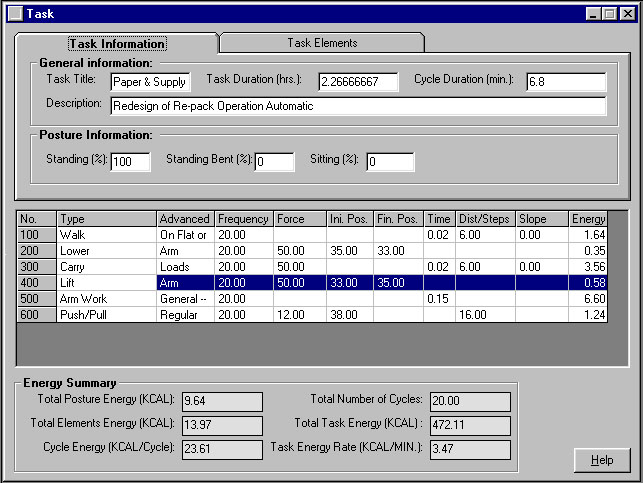The following job analysis presents an example illustrating the performance of the EEPP software:
Step 1: Determine task work elements
The Paper and Supply Co. repackages cases of copy machine paper. Workers must carry the cases from a pallet to a work table, remove the paper from the cases, and push the reams onto a conveyor. One work cycle, defined as the time to process an entire pallet of 20 cases stacked in 4 tiers, takes 6.8 minutes. Each case is 50 lbs. and is 10″ high. The worker is male, weighs 130 lbs., and has a carry height of 33″. The average time it takes him to walk 11 feet from the 35″ high worktable to the 4″ high pallet is 0.04 minutes. It takes 0.15 minutes to unload a case. A 12 lb. push force is necessary to move the paper the 16″ across the table onto the conveyor.
Task work elements:
- Walk to pallet
- Lift case of paper from pallet
- Carry to work table
- Place case on work table
- Remove paper from case
- Push paper onto conveyor
Step 2: Enter data into EEPP
The following screenshot illustrates EEPP after the data has been entered.

Step 3: Perform the Analysis of Output and Job redesign
A glance at the summary energy expenditure rate of 4.94 kcal/min at the bottom of the screenshot above alerts the safety engineer that the job exceeds the 3.5 kcal/min action limit design guideline for an average 8 hour day recommended by the National Institute for Occupational Safety and Health (NIOSH) in 1981. However, the rate is less than the 5.0 kcal/min maximum permissible limit guideline (NIOSH 1981) which describes the job as acceptable if administrative controls (awareness training, physical exams, monitoring, etc.) are invoked.
The right-hand column above indicates that it is more arduous to lift cases from the lower levels on the pallet. Carrying the cases to the work station is also a high fatigue factor.
The safety engineer redesigns the job by installing an automatic pallet lift device that will eliminate the worker’s need to bend when he lifts. With the new device, all cases can now be lifted at the same optimum height. The job is also changed by moving the pallet closer to the work table. The worker’s walk distance is reduced to 6 feet.
Data from the job changes are entered into the program resulting in the following screenshot:

The energy expenditure rate has been reduced to 3.47 kcal/min. Based upon the 1981 NIOSH Guide data, the safety engineer could expect 75% of women and 99% of men to be able to perform the job with only nominal risk. Administrative controls such as designated rest breaks would reduce the risk even further. Note that in 1991 the NIOSH Guideline was reduced to 3.2 kcal/min to accommodate more women and men.
